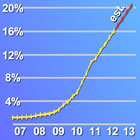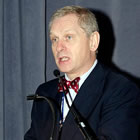 On September 22-23, 2016, the 5th Advanced International Masterclass on the Transradial Approach will be held in Budapest, Hungary. And this year, AimRADIAL will be preceded on September 21 by a one-day comprehensive workshop covering all aspects of Fractional Flow Reserve (FFR) from the basic principles and set-up in the cath lab, to the differences between FFR, iFR, and CFR, a comprehensive review of the clinical study data so far, and finally a look at future modalities, like FFR-CT (although the title of that talk by Dr. Nick Curzen is “FFR-CT: the future is now“).
On September 22-23, 2016, the 5th Advanced International Masterclass on the Transradial Approach will be held in Budapest, Hungary. And this year, AimRADIAL will be preceded on September 21 by a one-day comprehensive workshop covering all aspects of Fractional Flow Reserve (FFR) from the basic principles and set-up in the cath lab, to the differences between FFR, iFR, and CFR, a comprehensive review of the clinical study data so far, and finally a look at future modalities, like FFR-CT (although the title of that talk by Dr. Nick Curzen is “FFR-CT: the future is now“).
FFR Workshop
This one-day workshop looks to be a most interesting series of sessions, due to the fact that there are over a dozen expert faculty from different countries, some of whom are not exactly in agreement with each other about aspects of physiologic assessment. You will hear from the developers of FFR, and from the developers of an alternative adenosine-free technology iFR. I have been in sessions at the TCT and ACC where contentious voices of panelists were raised about which dataset was valid, which technique more accurate, and so forth. But at the AimRADIAL FFR Workshop, many of these voices will be all together in the same room. We’re talking Bernard De Bruyne, Justin Davies, Nils Johnson, Colin Berry, and — well here’s the list of faculty. If you want to learn about FFR, have September 21 available, and would like to spend a night in the beautiful city of Budapest, then sign up here.
AimRADIAL Masterclass
Or add a couple more days to hear from, talk to, and network with almost 100 of the most experienced radialists in the world: Dr. Tejas Patel from India, Shigeru Saito from Japan, members of the Slender Club like Drs. Yoshimachi, Matsukage, etc. And leaders from the U.S., England, Italy, The Netherlands, and well, so as not to slight anyone, here’s the list!
If you already perform or want to start using the wrist approach to diagnostic or interventional procedures, you need to attend. Where else will you be able to spend two-days with the most expert and experienced radial practitioners in the world?
I went to the last three AimRADIAL courses in New York City, Chicago, and Liverpool and, as I have written previously, I witnessed something I hadn’t really seen since the early days of angioplasty: a relatively small meeting (i.e. less than 300) attended by the pioneers of the procedure, cardiologists who have the largest experience in the radial approach, talking among themselves and trading their latest findings and techniques with each other, and sharing this information with the newer generation of physicians in attendance. It was an actual community!
AimRADIAL is a different vibe from the massive meetings like TCT or EuroPCR, more personal and, of course, with a very specific agenda: doing procedures from the wrist. It was great to see so many of the physicians who in little more than a decade have changed the procedure of angioplasty worldwide to increase patient safety, comfort and outcomes.
This year the AimRADIAL Masterclass course organizers are Olivier F Bertrand, MD PhD of Quebec (QC), Canada and Zoltan Ruzsa, MD PhD of Budapest, Hungary
There also will be five live cases, taped demonstrations and a wide spectrum of talks, addressing all aspects of the transradial approach, including a special Endovascular thread for interventions in the leg, kidney, etc. The use of the transradial approach in endovascular procedures is a fast-growing area for interventional radiologists.
So…if you’re thinking of attending AimRADIAL 2016, check out the distinguished faculty, and check out the program agenda.
* * * * * * * *
 When we started the Transradial Access Center on Angioplasty.Org back in 2007, less than 2% of U.S. procedures were performed via the wrist; nine years later the figure is around 20-25%, a greater-than-ten-fold increase. During this period there have also been a number of clinical studies and analyses of data, all pointing to the fact that the wrist approach can lead to lower costs, less complications, better 30-day and long-term outcomes and, oh yeah, better patient comfort! Almost every patient who has experienced catheter-based procedures from both the femoral and radial approaches has strongly preferred the radial every time.
When we started the Transradial Access Center on Angioplasty.Org back in 2007, less than 2% of U.S. procedures were performed via the wrist; nine years later the figure is around 20-25%, a greater-than-ten-fold increase. During this period there have also been a number of clinical studies and analyses of data, all pointing to the fact that the wrist approach can lead to lower costs, less complications, better 30-day and long-term outcomes and, oh yeah, better patient comfort! Almost every patient who has experienced catheter-based procedures from both the femoral and radial approaches has strongly preferred the radial every time.
And then there’s the hard data. Published in a 2014 issue of the Journal of the American College of Cardiology, a study of 350,000 patients in the UK concluded:
TRA [TransRadial Angioplasty] was independently associated with reduced 30-day mortality, and the magnitude of this effect was related to baseline bleeding risk; those at highest risk of bleeding complications gained the greatest benefit from adoption of TRA during PCI.
The European Society of Cardiology guidelines for the treatment of patients with acute coronary syndromes (ACS) currently recommend that the radial approach is the preferred approach (over the femoral) because it has been demonstrated to reduce mortality! Read our article, “European Guidelines Say “Radial First“, about this issue.

Dr. Olivier Bertrand
Back to the AimRADIAL course, co-organizer and radial pioneer, Olivier F. Bertrand, MD, PhD, told Angioplasty.Org that “Besides usual themes, special emphasis will be placed this year on 1) peripheral intervention and radial approach, 2) use of dedicated universal catheters versus standard catheters, 3) cost benefits for radial approach in the USA and around the world, including new practice such as same-day discharge, 4) how to use new anticoagulants and new antiplatelets in the lab, 5) radial artery injury and occlusion: prevention and treatment.”
This last point is interesting. Because the radial approach is positioned as a safer alternative to femoral, most radialists are very sensitive to the subject of complications. And, like any medical procedure, there are complications to the transradial approach, but they are small in percentage. However, they do exist and there are several lectures on the program about possible complications, how to avoid them, and what to do about them when they occur.
Finally, the course is not just for doctors. One of the course faculty is Bernadette Speiser, RN. There’s no question that a radial program in a hospital can only be successful when the entire cath lab team is on-board. So emphasis on the nursing, tech and ancillary staff is central to the procedure.
More information about AimRADIAL can be found on the course web site at AIMRADIAL.org. Registration for the course can be found here.
(Photo of Budapest Parliament by Epistola8 is licensed under CC BY-SA 4.0.)



